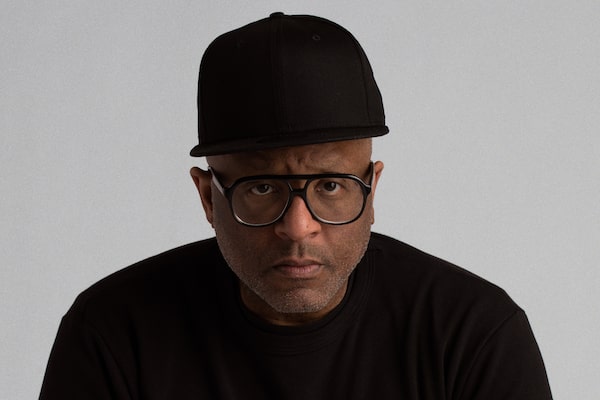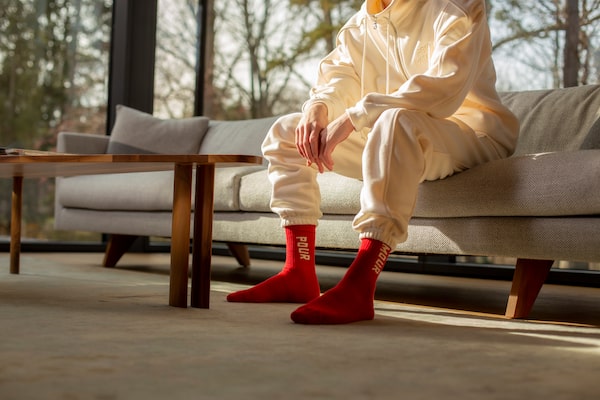
Designer Adrian Aitcheson, founder of Too Black guys, chief design officer of October's Very Own and designer of the new label Pour l'Amour.Courtesy of Pour l'Amour
Since founding the label Too Black Guys in 1990, Adrian Aitcheson has developed a keen awareness of the intersection between culture, creativity and commerce. Building off the success of the Toronto-based brand – which found fans in Mary J. Blige, Spike Lee and Drake – Aitcheson went on to hold key roles at Roots, Ecko Unlimited, Canada Goose and October’s Very Own (OVO).
In late 2021, Aitcheson founded Pour l’Amour, an apparel and accessory company focused largely on made-in-Canada wardrobe staples including sweatsuits, varsity jackets and denim. As he prepares to launch his spring pieces, Aitcheson spoke to The Globe and Mail about homegrown attitude, the history of streetwear and why the traditional fashion model is getting a much-needed makeover.
Before we talk about Pour l’Amour, I want to go back to the beginning and the launch of Too Black Guys. Streetwear has become such a broad term and I’m curious to hear what it was like founding the brand and watching the category change over the past decades.
How much time do you have? Before “streetwear,” it was called “urban.” And before “urban,” there wasn’t even a category. It was just a bunch of people in different pockets – for the most part in big cities like New York, London, Los Angeles and then, along came Toronto – we were making clothes for our friends and people in our community. I think the objective at that point was having a business that was successful enough to be able to employ your friends and pay your bills. I don’t think any of us who started at that time thought much bigger than that.
As urban became popular, it became kind of downmarket. New influences arose and the sort of streetwear born out of that was, I guess, a reaction to how big urban got. People started thinking, “This isn’t why I started doing this. I didn’t want to be in Macy’s.” We rode the wave from the beginning of urban – which is sort of a polite way of saying “Black fashion” or “thug fashion” – through to when it evolved into streetwear; and streetwear evolved into mainstream [fashion]. Streetwear was originally counterculture, and then it became the culture; and I think the meaning began to fade away.

Model wearing new label Pour l'Amour by Aitcheson.Courtesy of Pour l'Amour
So many styles were born out of community-centric movements. Suddenly it gets co-opted and there has to be another reaction and movement.
Yeah, and I don’t know if there’s going to be a category that’s going to emerge out of this because the internet has democratized design. If you have an idea, and you want to start a clothing brand, then, you know, one Shopify account later, you’re in business. The importance of the industry is so diminished at this point that I don’t think there’s going to be a singular category that’s going to take over. It’s going to be a group of people who are doing a thing in Paris, and it can be popular just in Paris. Or, it may spread to the world. But you can create these little microeconomies with your own vision, and stay true to that vision because you don’t have to seek acceptance from the greater market. I think there’s an opportunity for the independence that streetwear was born out of to re-emerge, just in a completely different way.
What you’re describing sounds like it would have been a consideration in terms of your work with OVO.
To me, that’s the future. They basically built their own community and they’re talking to the community, [and] they’re trading with their community. And they don’t really need anything else. It’s a whole new ecosystem and they’re completely self-sufficient.
This concept feels important to sustainability; brands making limited edition items, and pieces are going into the hands of the people who really want them instead of languishing on a rack.
And it gets traded within the community. Someone will buy [a piece], then they’ll put it on a [resale] site like Grailed, and someone else will buy it, they’ll wear for a while, and then someone else will buy it. It’s not disposable; for example, the same coveted pair of sneakers may be worn by three or four different people.

In late 2021, Aitcheson founded Pour l’Amour, an apparel and accessory company focused largely on made-in-Canada wardrobe staples including sweatsuits, varsity jackets and denim.Courtesy of Pour l'Amour
You mention “Canadian style” as being part of Pour l’Amour’s DNA. Tell me about how your perception of Canadian style has evolved.
Canadian style is a lot like Canada itself. We have relied on other people to identify us. What I wanted to do is take control of our own identity, and help to coalesce all the things I see that are unique about Canadian style and that will be unique in the marketplace. Here, fashion comes from function and our relationship to the outdoors, regardless of season. That’s the grounding of our style, and there’s a certain practicality that in and of itself is stylish. When you look at how Canadians dress, we don’t take ourselves too seriously and there are certain things we do really well that we don’t take credit for – like sweats, like outerwear, like denim. Doing that well is a north star for Pour l’Amour.
How did you land on that name?
When I was leaving OVO and thinking about what I was going to do next, I was talking to my wife about starting another brand. And she said, “You’ve been doing this a long time – you know how much work it is. Why would you want to do this?” And my answer was, for the love of it.
This interview has been condensed and edited.
Sign up for The Globe’s arts and lifestyle newsletters for more news, columns and advice in your inbox.